Healthcare Study Critique: Transforming Care Programme Analysis Report
VerifiedAdded on 2022/11/19
|5
|1084
|214
Report
AI Summary
This report offers a critical analysis of the healthcare study conducted by Head et al. (2018), which investigated the experiences of individuals with learning disabilities transitioning out of hospitals as part of the Transforming Care Programme. The study utilized semi-structured interviews and grounded theory methods to explore participants' experiences before, during, and after their move. The report evaluates the study's methodology, including the use of qualitative interviews and the sample size of 11 participants. The critique examines the validity, reliability, and generalizability of the findings, focusing on themes such as 'being in relationship with others' and 'changing ideas about who I am'. The report also assesses the study's strengths, such as the use of participant narratives to enhance trustworthiness and the personalized approach to interviews, as well as its limitations and implications for future research in healthcare settings. The report also highlights the importance of the research in understanding the effects of the Transforming Care Programme.
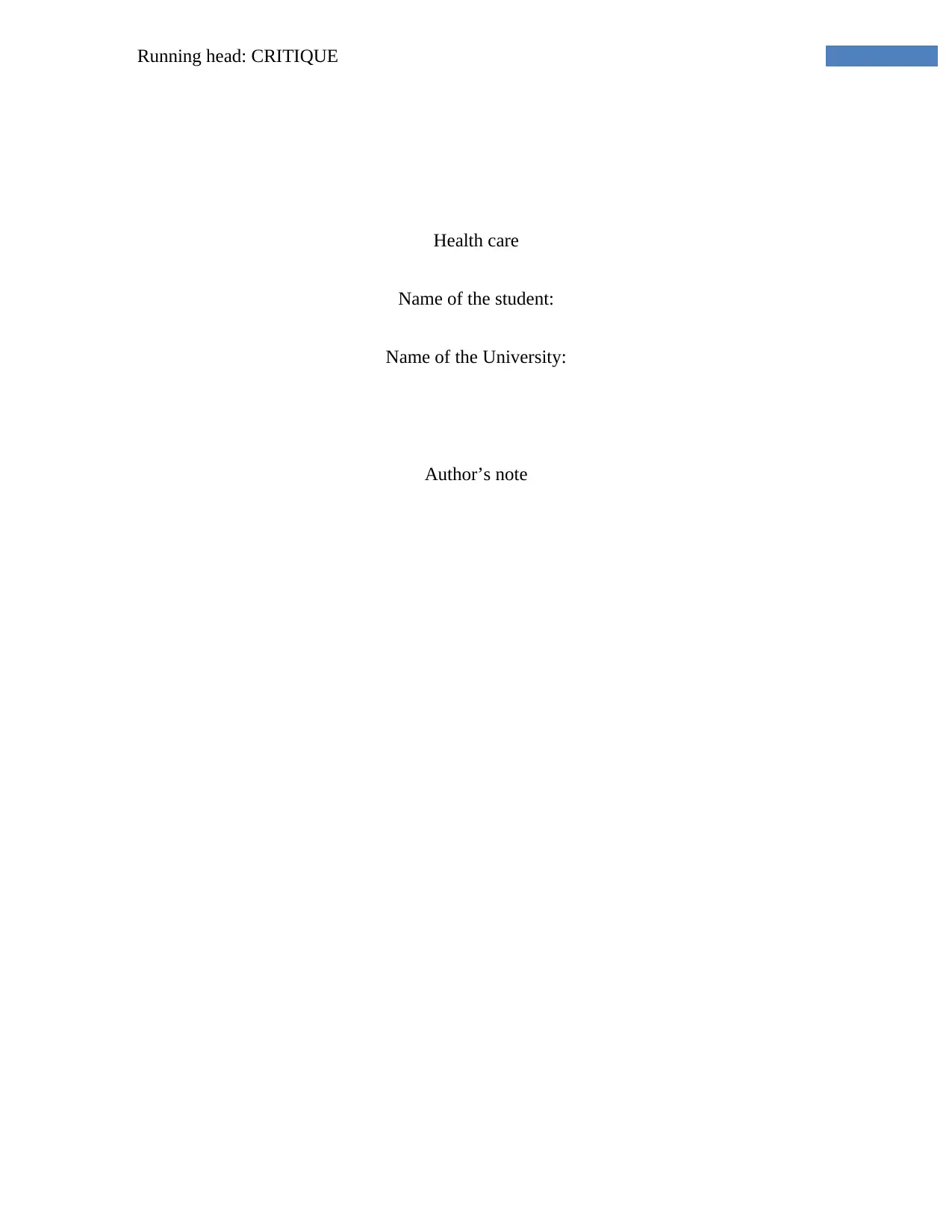
Running head: CRITIQUE
Health care
Name of the student:
Name of the University:
Author’s note
Health care
Name of the student:
Name of the University:
Author’s note
Paraphrase This Document
Need a fresh take? Get an instant paraphrase of this document with our AI Paraphraser
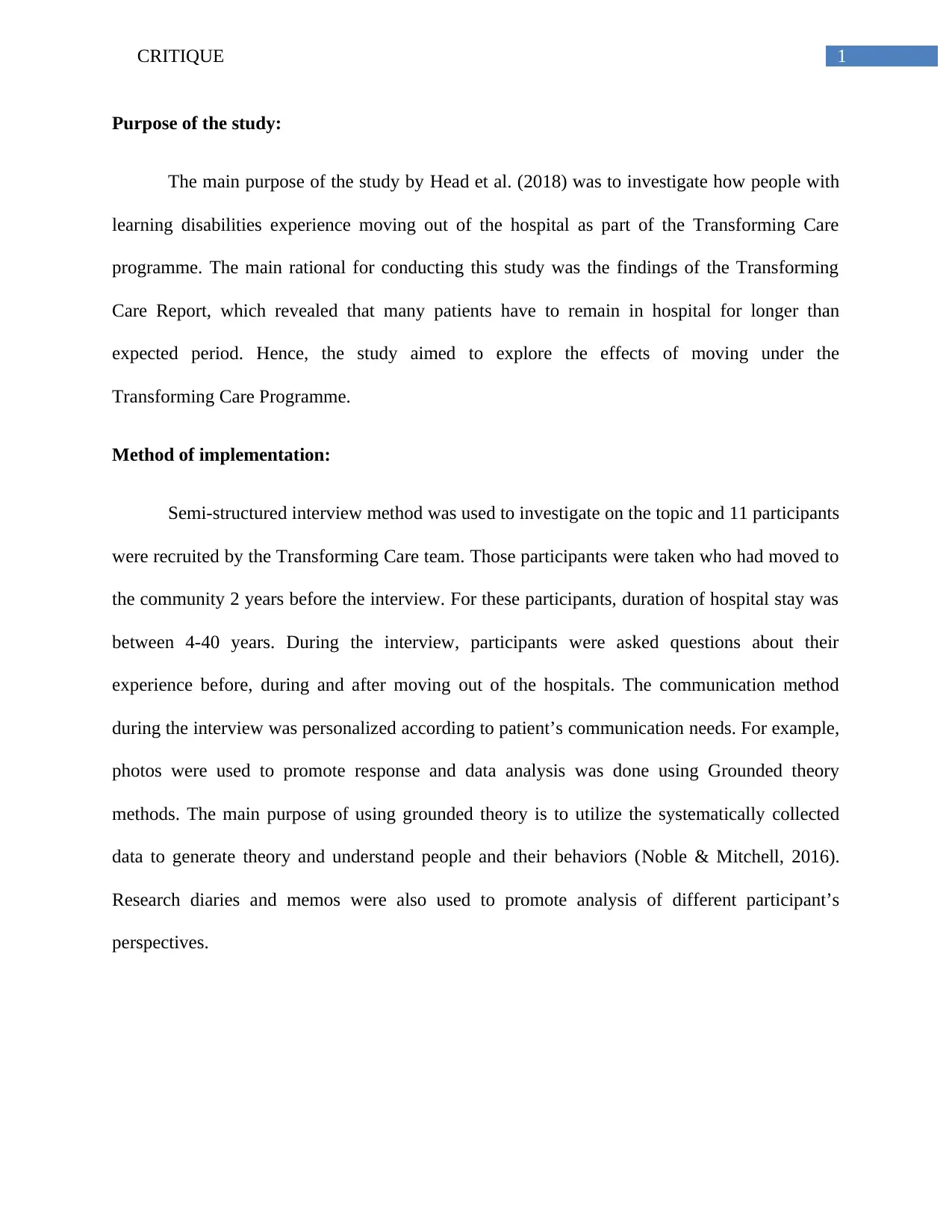
1CRITIQUE
Purpose of the study:
The main purpose of the study by Head et al. (2018) was to investigate how people with
learning disabilities experience moving out of the hospital as part of the Transforming Care
programme. The main rational for conducting this study was the findings of the Transforming
Care Report, which revealed that many patients have to remain in hospital for longer than
expected period. Hence, the study aimed to explore the effects of moving under the
Transforming Care Programme.
Method of implementation:
Semi-structured interview method was used to investigate on the topic and 11 participants
were recruited by the Transforming Care team. Those participants were taken who had moved to
the community 2 years before the interview. For these participants, duration of hospital stay was
between 4-40 years. During the interview, participants were asked questions about their
experience before, during and after moving out of the hospitals. The communication method
during the interview was personalized according to patient’s communication needs. For example,
photos were used to promote response and data analysis was done using Grounded theory
methods. The main purpose of using grounded theory is to utilize the systematically collected
data to generate theory and understand people and their behaviors (Noble & Mitchell, 2016).
Research diaries and memos were also used to promote analysis of different participant’s
perspectives.
Purpose of the study:
The main purpose of the study by Head et al. (2018) was to investigate how people with
learning disabilities experience moving out of the hospital as part of the Transforming Care
programme. The main rational for conducting this study was the findings of the Transforming
Care Report, which revealed that many patients have to remain in hospital for longer than
expected period. Hence, the study aimed to explore the effects of moving under the
Transforming Care Programme.
Method of implementation:
Semi-structured interview method was used to investigate on the topic and 11 participants
were recruited by the Transforming Care team. Those participants were taken who had moved to
the community 2 years before the interview. For these participants, duration of hospital stay was
between 4-40 years. During the interview, participants were asked questions about their
experience before, during and after moving out of the hospitals. The communication method
during the interview was personalized according to patient’s communication needs. For example,
photos were used to promote response and data analysis was done using Grounded theory
methods. The main purpose of using grounded theory is to utilize the systematically collected
data to generate theory and understand people and their behaviors (Noble & Mitchell, 2016).
Research diaries and memos were also used to promote analysis of different participant’s
perspectives.
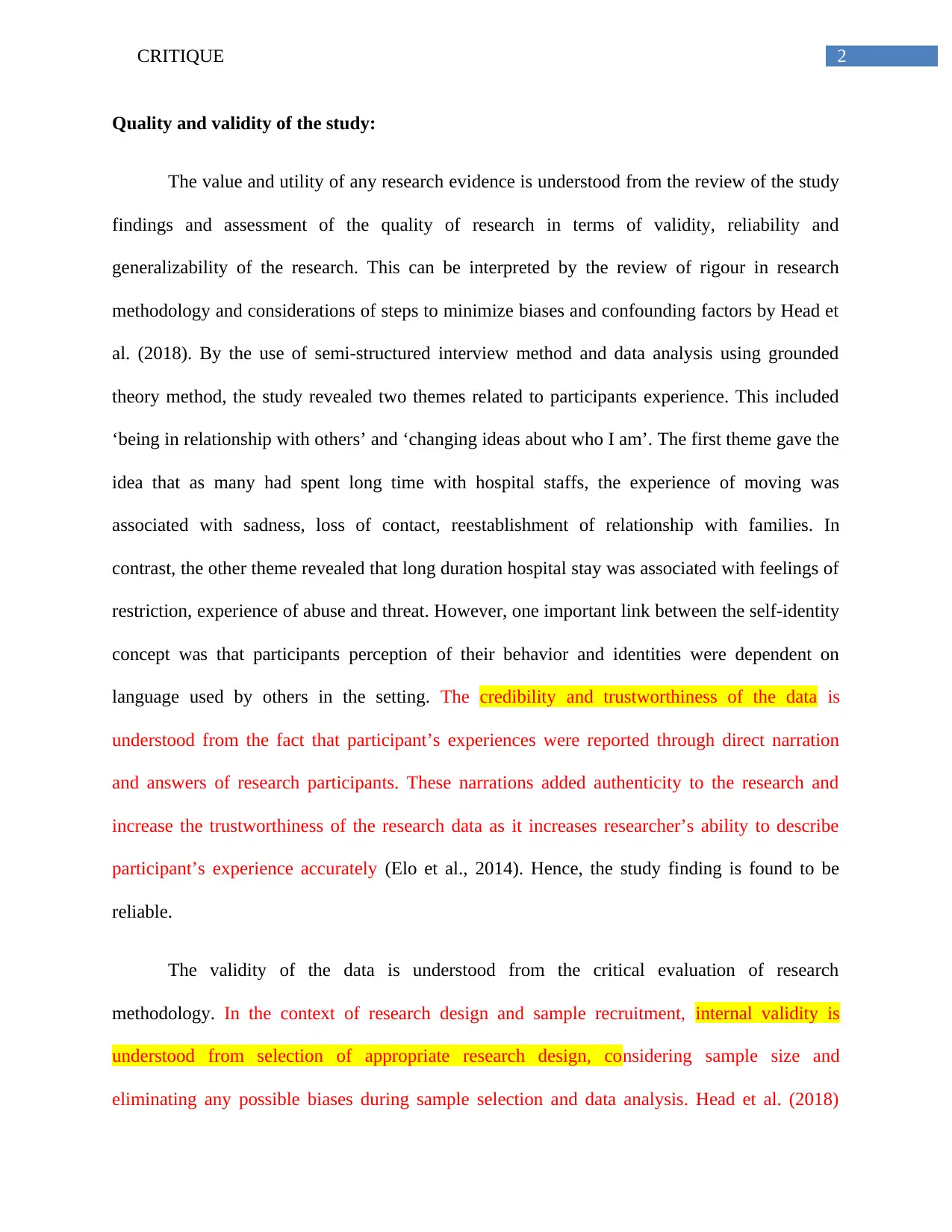
2CRITIQUE
Quality and validity of the study:
The value and utility of any research evidence is understood from the review of the study
findings and assessment of the quality of research in terms of validity, reliability and
generalizability of the research. This can be interpreted by the review of rigour in research
methodology and considerations of steps to minimize biases and confounding factors by Head et
al. (2018). By the use of semi-structured interview method and data analysis using grounded
theory method, the study revealed two themes related to participants experience. This included
‘being in relationship with others’ and ‘changing ideas about who I am’. The first theme gave the
idea that as many had spent long time with hospital staffs, the experience of moving was
associated with sadness, loss of contact, reestablishment of relationship with families. In
contrast, the other theme revealed that long duration hospital stay was associated with feelings of
restriction, experience of abuse and threat. However, one important link between the self-identity
concept was that participants perception of their behavior and identities were dependent on
language used by others in the setting. The credibility and trustworthiness of the data is
understood from the fact that participant’s experiences were reported through direct narration
and answers of research participants. These narrations added authenticity to the research and
increase the trustworthiness of the research data as it increases researcher’s ability to describe
participant’s experience accurately (Elo et al., 2014). Hence, the study finding is found to be
reliable.
The validity of the data is understood from the critical evaluation of research
methodology. In the context of research design and sample recruitment, internal validity is
understood from selection of appropriate research design, considering sample size and
eliminating any possible biases during sample selection and data analysis. Head et al. (2018)
Quality and validity of the study:
The value and utility of any research evidence is understood from the review of the study
findings and assessment of the quality of research in terms of validity, reliability and
generalizability of the research. This can be interpreted by the review of rigour in research
methodology and considerations of steps to minimize biases and confounding factors by Head et
al. (2018). By the use of semi-structured interview method and data analysis using grounded
theory method, the study revealed two themes related to participants experience. This included
‘being in relationship with others’ and ‘changing ideas about who I am’. The first theme gave the
idea that as many had spent long time with hospital staffs, the experience of moving was
associated with sadness, loss of contact, reestablishment of relationship with families. In
contrast, the other theme revealed that long duration hospital stay was associated with feelings of
restriction, experience of abuse and threat. However, one important link between the self-identity
concept was that participants perception of their behavior and identities were dependent on
language used by others in the setting. The credibility and trustworthiness of the data is
understood from the fact that participant’s experiences were reported through direct narration
and answers of research participants. These narrations added authenticity to the research and
increase the trustworthiness of the research data as it increases researcher’s ability to describe
participant’s experience accurately (Elo et al., 2014). Hence, the study finding is found to be
reliable.
The validity of the data is understood from the critical evaluation of research
methodology. In the context of research design and sample recruitment, internal validity is
understood from selection of appropriate research design, considering sample size and
eliminating any possible biases during sample selection and data analysis. Head et al. (2018)
⊘ This is a preview!⊘
Do you want full access?
Subscribe today to unlock all pages.

Trusted by 1+ million students worldwide
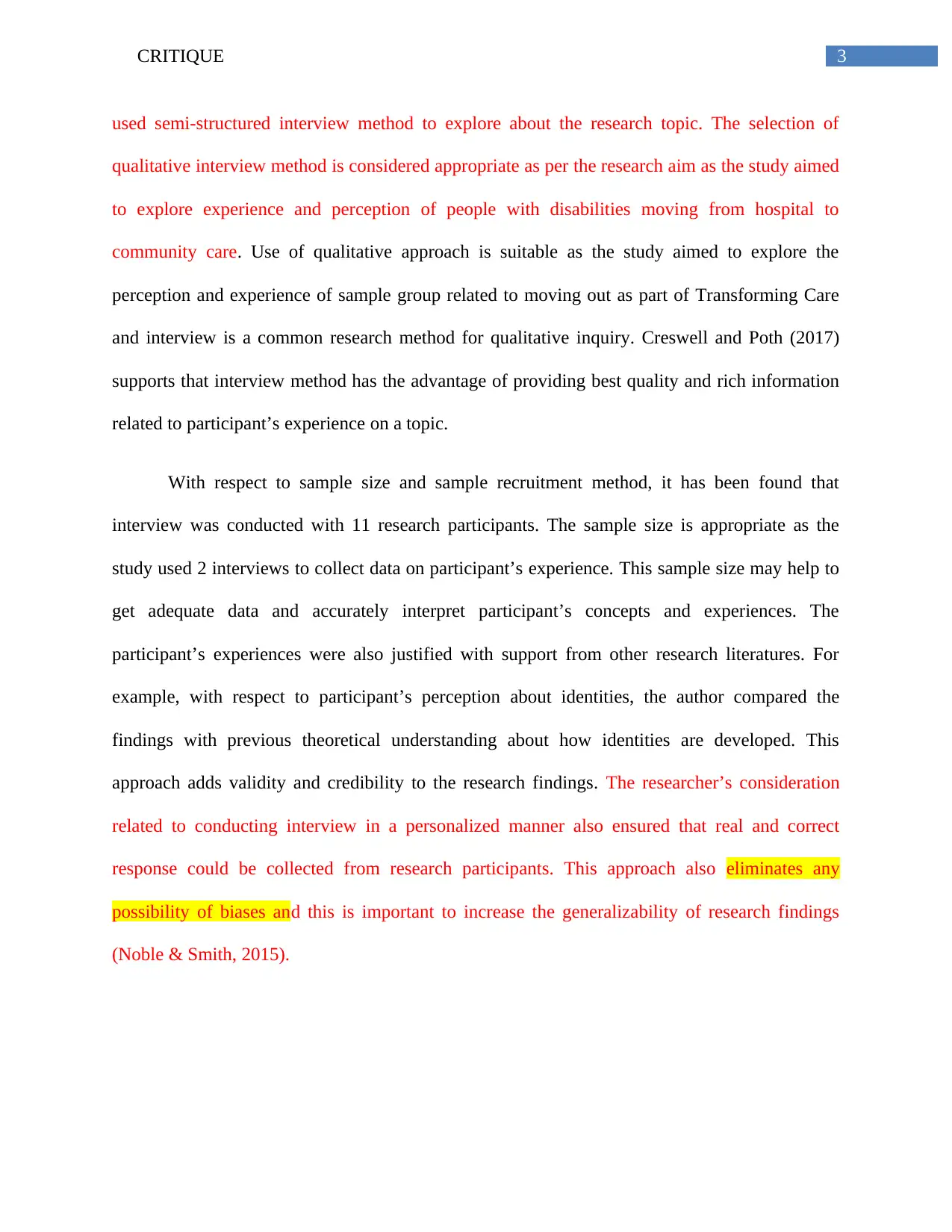
3CRITIQUE
used semi-structured interview method to explore about the research topic. The selection of
qualitative interview method is considered appropriate as per the research aim as the study aimed
to explore experience and perception of people with disabilities moving from hospital to
community care. Use of qualitative approach is suitable as the study aimed to explore the
perception and experience of sample group related to moving out as part of Transforming Care
and interview is a common research method for qualitative inquiry. Creswell and Poth (2017)
supports that interview method has the advantage of providing best quality and rich information
related to participant’s experience on a topic.
With respect to sample size and sample recruitment method, it has been found that
interview was conducted with 11 research participants. The sample size is appropriate as the
study used 2 interviews to collect data on participant’s experience. This sample size may help to
get adequate data and accurately interpret participant’s concepts and experiences. The
participant’s experiences were also justified with support from other research literatures. For
example, with respect to participant’s perception about identities, the author compared the
findings with previous theoretical understanding about how identities are developed. This
approach adds validity and credibility to the research findings. The researcher’s consideration
related to conducting interview in a personalized manner also ensured that real and correct
response could be collected from research participants. This approach also eliminates any
possibility of biases and this is important to increase the generalizability of research findings
(Noble & Smith, 2015).
used semi-structured interview method to explore about the research topic. The selection of
qualitative interview method is considered appropriate as per the research aim as the study aimed
to explore experience and perception of people with disabilities moving from hospital to
community care. Use of qualitative approach is suitable as the study aimed to explore the
perception and experience of sample group related to moving out as part of Transforming Care
and interview is a common research method for qualitative inquiry. Creswell and Poth (2017)
supports that interview method has the advantage of providing best quality and rich information
related to participant’s experience on a topic.
With respect to sample size and sample recruitment method, it has been found that
interview was conducted with 11 research participants. The sample size is appropriate as the
study used 2 interviews to collect data on participant’s experience. This sample size may help to
get adequate data and accurately interpret participant’s concepts and experiences. The
participant’s experiences were also justified with support from other research literatures. For
example, with respect to participant’s perception about identities, the author compared the
findings with previous theoretical understanding about how identities are developed. This
approach adds validity and credibility to the research findings. The researcher’s consideration
related to conducting interview in a personalized manner also ensured that real and correct
response could be collected from research participants. This approach also eliminates any
possibility of biases and this is important to increase the generalizability of research findings
(Noble & Smith, 2015).
Paraphrase This Document
Need a fresh take? Get an instant paraphrase of this document with our AI Paraphraser
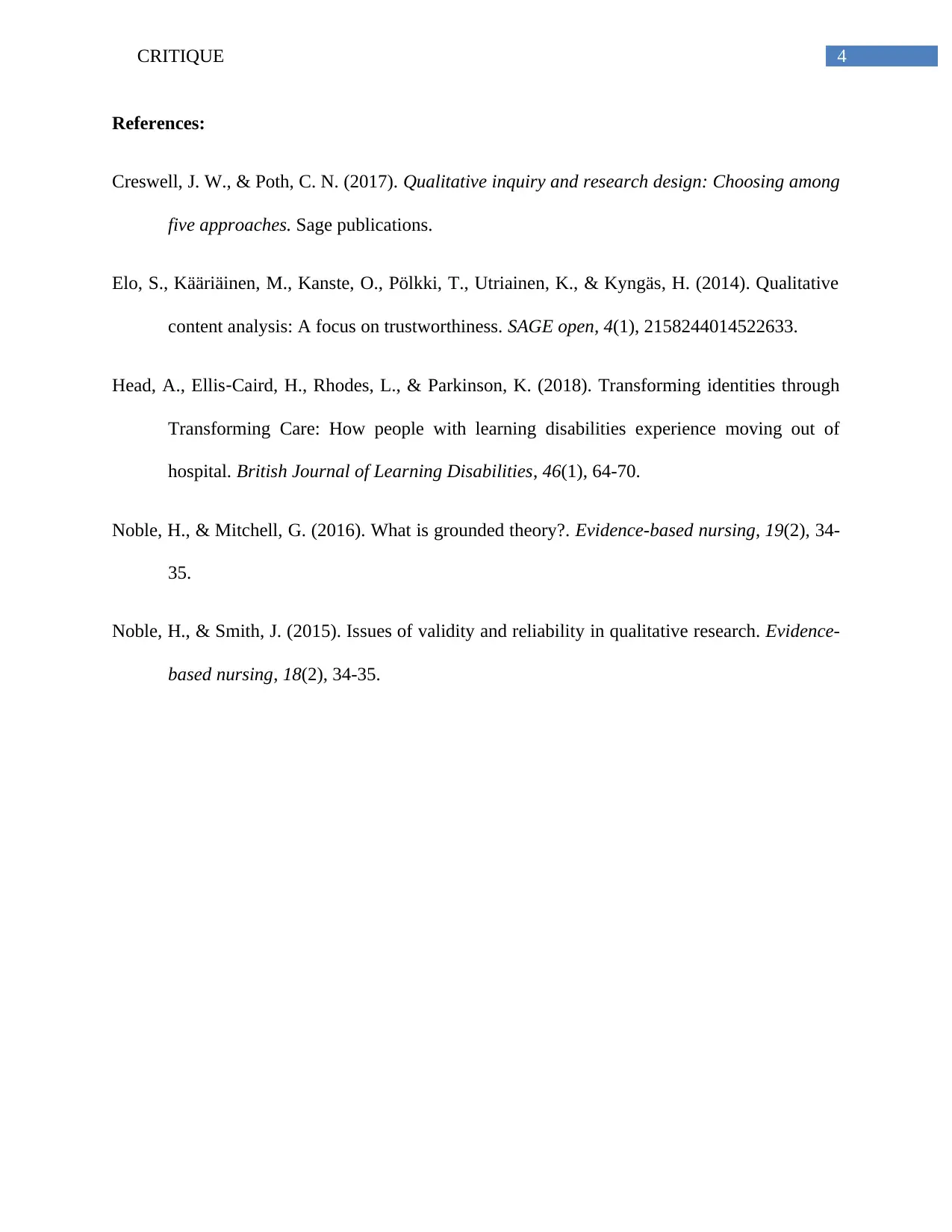
4CRITIQUE
References:
Creswell, J. W., & Poth, C. N. (2017). Qualitative inquiry and research design: Choosing among
five approaches. Sage publications.
Elo, S., Kääriäinen, M., Kanste, O., Pölkki, T., Utriainen, K., & Kyngäs, H. (2014). Qualitative
content analysis: A focus on trustworthiness. SAGE open, 4(1), 2158244014522633.
Head, A., Ellis‐Caird, H., Rhodes, L., & Parkinson, K. (2018). Transforming identities through
Transforming Care: How people with learning disabilities experience moving out of
hospital. British Journal of Learning Disabilities, 46(1), 64-70.
Noble, H., & Mitchell, G. (2016). What is grounded theory?. Evidence-based nursing, 19(2), 34-
35.
Noble, H., & Smith, J. (2015). Issues of validity and reliability in qualitative research. Evidence-
based nursing, 18(2), 34-35.
References:
Creswell, J. W., & Poth, C. N. (2017). Qualitative inquiry and research design: Choosing among
five approaches. Sage publications.
Elo, S., Kääriäinen, M., Kanste, O., Pölkki, T., Utriainen, K., & Kyngäs, H. (2014). Qualitative
content analysis: A focus on trustworthiness. SAGE open, 4(1), 2158244014522633.
Head, A., Ellis‐Caird, H., Rhodes, L., & Parkinson, K. (2018). Transforming identities through
Transforming Care: How people with learning disabilities experience moving out of
hospital. British Journal of Learning Disabilities, 46(1), 64-70.
Noble, H., & Mitchell, G. (2016). What is grounded theory?. Evidence-based nursing, 19(2), 34-
35.
Noble, H., & Smith, J. (2015). Issues of validity and reliability in qualitative research. Evidence-
based nursing, 18(2), 34-35.
1 out of 5
Related Documents
Your All-in-One AI-Powered Toolkit for Academic Success.
+13062052269
info@desklib.com
Available 24*7 on WhatsApp / Email
![[object Object]](/_next/static/media/star-bottom.7253800d.svg)
Unlock your academic potential
Copyright © 2020–2025 A2Z Services. All Rights Reserved. Developed and managed by ZUCOL.





